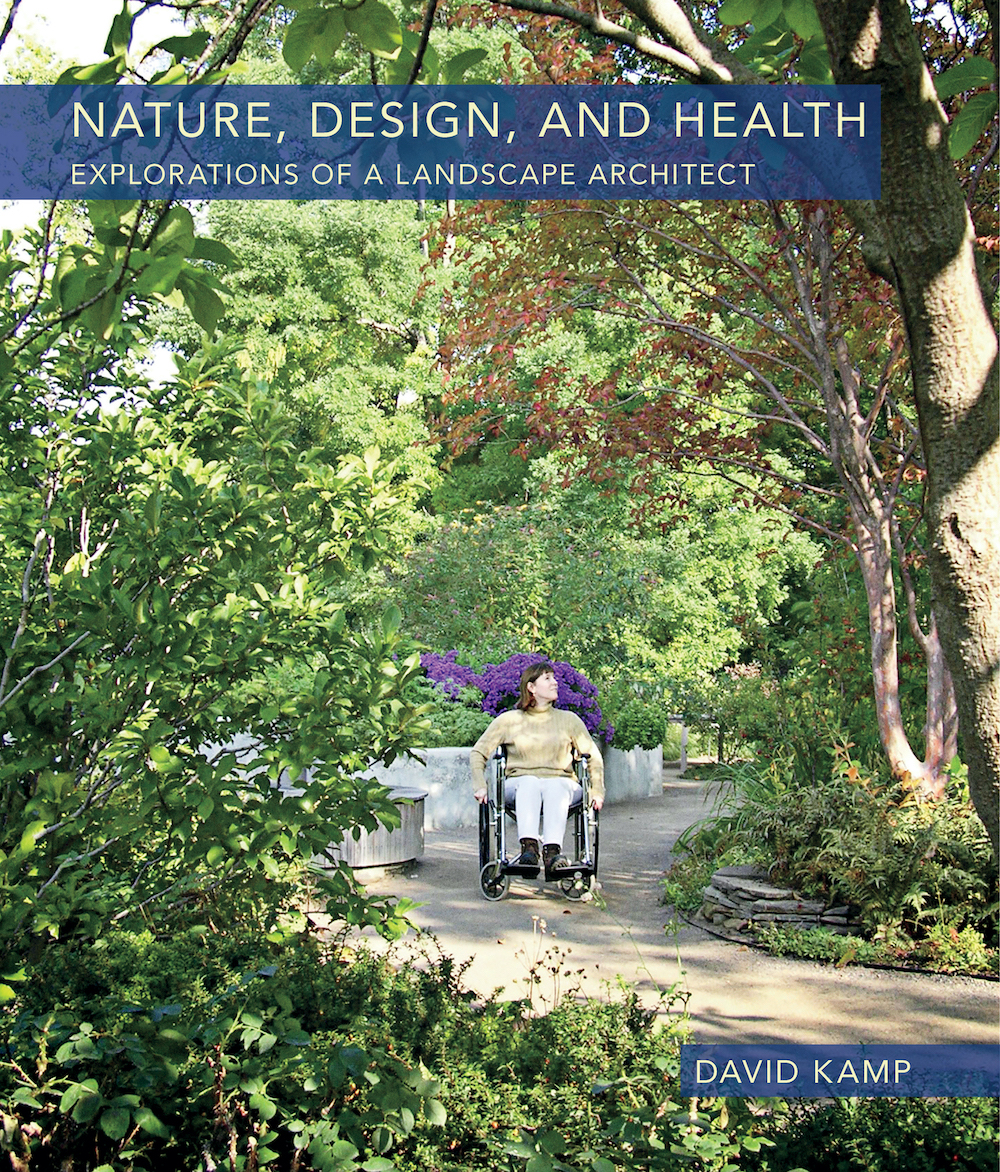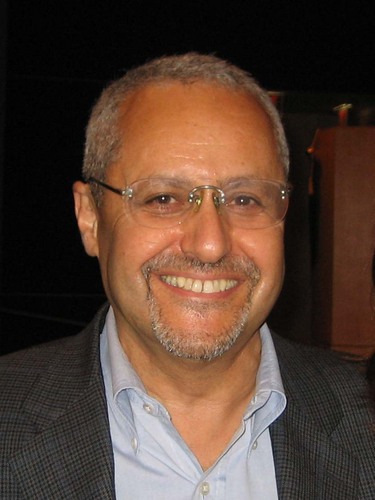Arts & culture / Access to nature
Book review: ‘Nature, Design, and Health: Explorations of a Landscape Architect’
By Andrew Sansom | 07 Sep 2023 | 0
Dr John Zeisel, an international expert on dementia care design and treatment innovations, finds the insights and experiences detailed in landscape architect David Kamp’s new book not only to be a fillip for the soul but a lesson in sensitive healing design from which everyone can benefit.
Nature, Design, and Health is a memoir illustrated with plans and photographs of designs that promote health – from healing gardens like the Schnaper Memorial AIDS rooftop garden in New York City and the agora-like Campus Commons at Birmingham, Alabama’s, Lakeshore Foundation, to landscapes for the Els Center of Excellence Autism Spectrum Disorder Garden in Jupiter, Florida, and the Natural Sciences Courtyard at Keene State College in New Hampshire.
A personal design manifesto
Insightful, at times surprising, and always instructive, I recommend Nature, Design, and Health to all landscape designers – students and professionals – and to all architects as well as non-designers with a love of gardening and desire to experience nature in all its intrinsic and designed glory.
The book’s overarching message is that every landscape designer working on a garden or landscape plan to improve health should look closely and experience deeply the natural world around them before touching it. Aligned with this fundamental teaching, David’s design manifesto champions the following insightful lessons. 
Uncover and discover nature’s patterns: Don’t impose an abstract design idea on the exciting, rich, design nature offers us, without first dwelling in grasses, streams, forests, and fields, to sense their natural order.
- Nature, to sensitive designers, is to be discovered and uncovered, not imposed upon. David opened my eyes to this, in a personal way, when he saw – and I’m not sure how, because it was completely covered with underbrush and vines – a tree at the front of my house (image, right). “You must uncover that magnificent oak tree,” David said, as he arrived for a visit with his partner Michael, who also features in the book. That tree greets me daily. Just yesterday, as a visitor and her husband were getting into their car to leave, she remarked: “What a marvellous tree.” Thank you, David.
A tree is more than meets the eye: To David, each tree is unique, such as the Pratt Ginko, Veitch Fir, and Yulan Magnolia at the University of Virginia. Each tree protects, enriches and creates place – hiding in plain sight, it reveals its offerings to the thoughtful designer.
- The landscape architect’s task, according to David, is to discover and uncover each tree’s special secrets: what it has to say; what it creates; what it means; and what it teaches “about space, exposure and privacy”. He describes sitting amid trees at night in the woods to sketch their magical shapes, and he shows how a single tree provides shade and place, transforming a barren New York City rooftop into a healing AIDS garden, as does the Honey Locust in the Schnaper garden.
Open all your senses: To heal and be healed – to design with nature – demands experiencing our surroundings authentically and with all one’s senses. Once birdwatching in the Netherlands with an experienced birdwatcher, I returned home proud to have observed 14 species. My companion, however, had observed 37 species. How could that be, I exclaimed! I had used my eyes; he, however, had used all his senses. To him, each birdsong was an “observation”, each fleeting movement of flight. David offers many insights on the need to open one’s sense:
- Through intimate personal stories, he instructs readers to use all our senses – not only sight but also hearing, smell, touch and taste, to both experience gardens and design them.
- Eliciting all the senses enables gardens to be accessible and healing to those with sensory losses, such as the sight-impaired at the Evans Restorative Gardens.
- David reminds us, too, that there is science behind such an approach and not only personal sensitivity. “Proprioception – the complex set of sensory perceptions that help us understand where our bodies are in space” – is essential to David’s landscape design approach. His healing “therapeutic” gardens fully touch each person moving, whether walking or in a wheelchair, whether sight impaired, living with dementia, or another disability.

Environment-Behaviour (E-B): The evidence-based professional and academic study of the relationship between physical environments and those who dwell in them – provides an essential context for sensitive design with nature. The E-B world that I happen to inhabit along with those who have influenced David’s work – Clare Cooper-Marcus, Roger Ulrich, Kirk Hamilton, Rachel and Stephan Kaplan, among them – offers research methods and data that enlighten every designer intent on creating environments that meet the needs of users. David embraces science, aware that it enriches, rather than drains, his creativity. In searching for each healing garden’s message, David never overlooks the chance to employ E-B methods in interviewing potential garden users, gaining insight into their perceptions, feelings, and needs.
Interdependent healing and nature: To heal, nature needs to be cared for just as those whose health needs that nature serves must be cared for. To heal, nature cannot be exploited and discarded. Landscape design – whether therapeutic gardens for people living with dementia or those with sight impairment – cannot be seen as a one-way street. If nature is to heal those it embraces, healing design must pay as much attention to heal natural settings as it does to nature’s health effects on its users – a two-way street. As David explains: “. . . to design an accommodating environment is to be sensitive not only to needs but also to what makes nature healthy. Nature cannot help us if it needs help.”
Invisible details: David is not above bringing magic into his gardens. However, unlike magicians who refuse to share their tricks, David reveals his – the use of what he calls “invisible details”. Consider, for instance, a low, stone sitting wall, in which one stone full of sparkling mica is embedded, an offering by a stone mason keen to leave his mark – almost hidden, yet joyfully discovered by observant garden users.
- The term “invisible details” is actually a misnomer, as although secret and hidden, David’s details are not invisible. Rather, they’re discoverable, providing garden dwellers and users with joy, amusement and elation.
- Bricklayers in public plazas and walkways employ this tactic to leave their mark for the initiated. Look for them. They will randomly group darker bricks into star patterns or other geometric shapes – observable only to those who know to look for them. The plaza in front of Boston City Hall is a wonderful example – with embedded brick patterns visible only from upper-storey windows and balconies, or in a drone photo in modern times.
Take your shoes off: To experience environments in their natural state, feel with your feet. It’s something David has been doing his entire life. As a child in Shelby, North Carolina, he spent hours around his house “enjoying the cool, moist clay oozing between my toes”. At Chartres cathedral, northern France, he took his shoes off to experience the mosaic floor just as the barefoot pilgrims had done for hundreds of years. And at the McDowell artists’ colony, David recalls the feeling of sinking his feet deep into the wet clay when he arrived. It’s a lesson we should all put into practice: take off your shoes.
It’s these types of insights that make this wonderful book both a treat for the mind and senses and a lesson in healing design – one from which we can all benefit.
Note for disclosure: In Nature, Design, and Health – www.naturedesignhealth.com – David mentions that we’ve learned a great deal from each other over the years. He and I are friends as well as professional colleagues. Our joint professional work – although not featured in the book – includes designs for therapeutic gardens for persons living with dementia in Pittsburgh, Atlanta, and outside New York City. David also planned two unbuilt gardens in projects I was involved with that didn’t ultimately progress – in Beverly, Massachusetts and Charlottesville, Virginia.
Nature, Design, and Health: Explorations of a Landscape Architect
Author: David Kamp
Published by: Library of American Landscape History
Price: $40.00
Pages: 256
https://lalh.org/books/featured/nature-design-and-health/
About the author and reviewer
 David Kamp, FASLA, LF, NA is the founding principal of Dirtworks, PC Landscape Architecture. Through practice, teaching, writing and advocacy, David’s leadership and contributions promoting health through design and nature are at the forefront of the profession. A Harvard Loeb Fellow in Advanced Environmental Studies, MacDowell Colony Fellow, and member of the National Academy of Design, David has been recognised through numerous awards and publications and featured in four nationally and internationally broadcast documentaries.
David Kamp, FASLA, LF, NA is the founding principal of Dirtworks, PC Landscape Architecture. Through practice, teaching, writing and advocacy, David’s leadership and contributions promoting health through design and nature are at the forefront of the profession. A Harvard Loeb Fellow in Advanced Environmental Studies, MacDowell Colony Fellow, and member of the National Academy of Design, David has been recognised through numerous awards and publications and featured in four nationally and internationally broadcast documentaries.
 Dr John Zeisel, an internationally renowned expert on dementia care and treatment innovations, has a background in sociology and architecture. He received a PhD from Columbia University, a Loeb Fellowship at Harvard’s Graduate School of Design, and an Honorary Doctor of Science from Salford University, UK. He is founding board member of the I’m Still Here Foundation which, through support for innovative inclusive, community-based arts and culture programmes, is redefining the public narrative of dementia from despair to hope.
Dr John Zeisel, an internationally renowned expert on dementia care and treatment innovations, has a background in sociology and architecture. He received a PhD from Columbia University, a Loeb Fellowship at Harvard’s Graduate School of Design, and an Honorary Doctor of Science from Salford University, UK. He is founding board member of the I’m Still Here Foundation which, through support for innovative inclusive, community-based arts and culture programmes, is redefining the public narrative of dementia from despair to hope.

